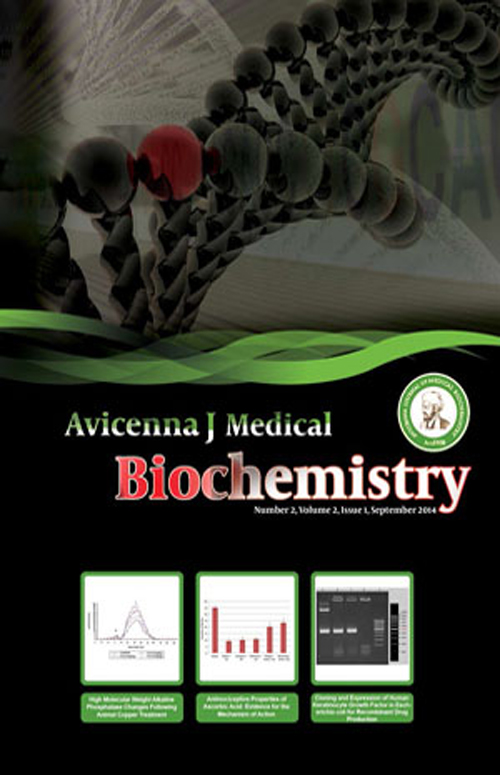فهرست مطالب

Avicenna Journal of Medical Biochemistry
Volume:6 Issue: 1, Jun 2018
- تاریخ انتشار: 1397/04/03
- تعداد عناوین: 5
-
-
Pages 3-7BackgroundDiabetes mellitus (DM) is one of the most common diseases in the world. Complications of this disease include nephropathy, cardiac arrest, blindness, and even mutilation of the body. The accurate diagnosis of this condition is very important.ObjectivesThis study was to identify and provide a model for diagnosis of DM using data mining.MethodsThe data used in this study were obtained from 768 women aged 21-83 year old. Nine variables were selected for investigation. The neural network, Basin network, C5.0, and support vector machine models were compared for predicting diabetes and their precision to this end. Clementine 12 software was used to analyze the data.ResultsThThe proposed method for classification of records with the C5.0 algorithm for accuracy data is 80.2% and for accuracy data 87.5%. In comparison with similar studies, it was better to diagnose people with diabetes, while glucose, body mass index and age variables were important in this study.ConclusionThe C5.0 algorithm showed the highest value of accuracy, specificity, and sensitivity compared with other methods studied. Therefore, the C5.0 algorithm probably performs the best classification among other algorithms and is recommended as the best method for diabetes prediction using available data.Keywords: Diabetes mellitus, Bayesian network, Neural network, Decision tree, Support vector machine, Data mining
-
Pages 8-14BackgroundMetabolic syndrome (MetS) increases the risk of diabetes. Olea europaea fruit exerts protective effects on metabolic disorders. Therefore, the aim of the present study was to investigate the effect of O. europaea fruit extracts on sucrose-induced MetS in rats.MethodsMale adult Wistar rats (200 ± 50 g, n = 32) were randomly divided into four groups (n = 8) consisting of control group, untreated sucrose group (sucrose 50% in drinking water for 10 weeks), sucrose plus aqueous extract of O. europaea fruit treated group (200 mg/kg) and sucrose plus hydroalcoholic extract of O. europaea fruit treated group (200 mg/kg) by gavage for 2 weeks. Body weight, serum glucose, insulin, leptin, lipid profile, homeostatic model assessment of insulin resistance (HOMA-IR) and hepatic enzymes were measured. Data were analyzed by one-way analysis of variance (ANOVA, SPSS, 16.0). P < 0.05 was regarded as significance level.ResultsThe aqueous extract exhibited higher protective effects on serum glucose, insulin and HOMA-IR than hydroalcoholic extract (P < 0.05). Body weight, serum glucose, leptin (P < 0.01), insulin, triglyceride, very-low-density lipoprotein cholesterol (VLDL-C), HOMA-IR, alkaline phosphatase (ALP), (P < 0.001) and aspartate aminotransferase (AST) (P < 0.05) significantly elevated but high-density lipoprotein cholesterol (HDL-C) (P < 0.05) decreased in the sucrose group. Aqueous extract of O. europaea fruit significantly improved blood glucose, triglyceride, VLDL-C (P < 0.01), insulin, HOMA-IR, ALP (P < 0.001), body weight, AST and leptin (P < 0.05) levels. Hydroalcoholic extract of O. europaea fruit significantly restored insulin, HOMA-IR (P < 0.01), ALP (P < 0.001), body weight, leptin, VLDL-C, triglyceride, blood glucose and AST (P < 0.05).ConclusionOur results indicated O. europaea fruit extracts could improve metabolic disorders induced by MetS in the rats.Keywords: Olea europaea, Sucrose, Metabolic syndrome, Hepatic enzymes, Leptin
-
Pages 15-20BackgroundOral squamous cell carcinoma is a major component of a diverse group of neoplasms often referred to as ‘head and neck cancer’. Frequent smoking and/or alcohol consumption are two major risk factors for oral cancer.ObjectivesThe present study was aimed to investigate the protective role of Pergularia daemia ethyl acetate and methanolic extracts (PDEAE and PDME, respectively) on glycoproteins in dimethylbenz(a) anthracene (DMBA) induced hamster buccal pouch carcinogenesis.Materials and MethodsMale golden Syrian hamsters were used and divided into six groups. Group 2 carried 0.5% 7,12-DMBA painting on left buccal pouch. Groups 3 and 4 were treated with DMBA and 300 mg/kg bwt of PDEAE and PDME by intragastric administration. Remaining groups served as untreated control. All the experiments were performed within 14 weeks.ResultsBody weight loss and 100% tumor incidence were observed treated hamsters with DMBA alone, whereas administration of PDEAE and PDME in animals with oral cancer caused significant alterations in body weight and tumor incidence. Further, plasma and buccal pouch tissue glycoprotein levels were increased and erythrocyte glycoprotein levels were depleted in DMBA treated hamsters. The levels were significantly reversed in hamsters treated with PDEAE and PDME at 300 mg/kg bwt.ConclusionPDEAE and PDME produce a significant protective effect against DMBA induced oral cancer by altering glycoproteins levels.Keywords: Pergularia daemia, Hamsters, Dimethylbenz(a)anthracene, Glyco proteins, Histopathology
-
Pages 21-23BackgroundDrug abuse is a global and critical problem. One of the most frequent practices done in order to detect the drugs of abuse is Urine Drug Screen. However, for changing the drug test results, adulterants and urine substitutes are being designed. As the referring people’s background has shown, ranitidine is one of the interfering drugs in morphine detection test. Therefore, in the present study, the interference of ranitidine in morphine detection test will be studied.MethodsTen healthy volunteers who had not used any kind of drug for 72 hours before the test were recruited into the study. First, 2 doses of ranitidine (150 and 300 mg) were administered to the subjects orally and 100-mL urine samples were collected from them before and after taking ranitidine. The second urine sample was collected at 6-8 am. Ten micrograms morphine was added to both urine samples of each individual. The urine samples were tested using thin-layer chromatography (TLC) technique. The experiment was repeated after 1 week using ranitidine 300 mg.ResultsThe TLC test was carried out on 40 urine samples. Twenty samples were tested before and, the rest, after ranitidine consumption. The TLC test results were positive before ranitidine consumption but negative for 18 samples and positive for two samples after taking ranitidine.ConclusionRanitidine may change the urine morphine screening test results via TLC method and induce a false negative result.Keywords: Addiction, Morphine, Drug Screen, Ranitidine

